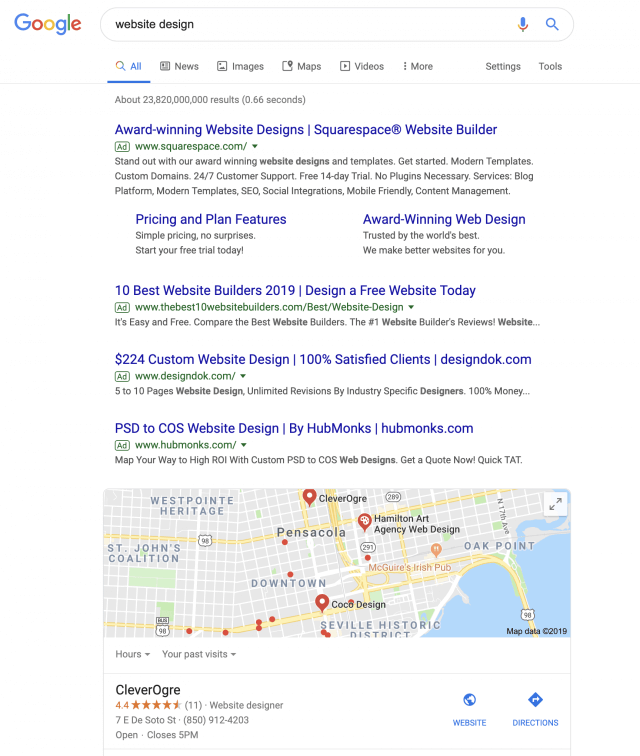Recently, one of our website and hosting clients typed in the brand name of one of the products he sells and found his competitor at the top of Google’s search engine results page (SERP). Why wasn’t his shiny, new CleverOgre website in the top spot? Could SEO help him get there?
We get it: When you invest several thousands of dollars into a website, you expect people to find it. Unfortunately, it’s not quite that simple. The internet is a crowded place and, depending on your industry, you may have to fight against dozens, hundreds, sometimes even thousands of other websites to stay on the top of those SERPs. Despite what you may have heard from a hazy yet handsome apparition in a corn field, you can’t just expect to “build it, and they will come.”
Even the best-built website doesn’t build demand for a product or service, but there are ways you can tap into existing demand through Search Engine Optimization (SEO). We thought the explanation we sent to our client might help you to understand the basics of SEO, too:

Why Isn’t My Website at the Top?
When you see your competitors listed at the very top of a search results page, chances are those are paid ads (look for the little green “Ad” square at the beginning of the first few listings). To get your own ads there, you’d have to bid more than your competitors in a Google Ads campaign.
For the rest of the ”natural” results below the ads, you’re talking about SEO, a huge topic with many, many factors involved. As we state in our proposals, we build sites that are “SEO-friendly.” Without getting too technical, we use clean code and follow current industry standards to construct sites in a way that makes it easy for Google and other search engines to crawl the site and figure out what your company offers.
Basic SEO Tactics
This provides a good foundation upon which to build an effective SEO strategy, but you won’t rise to the top — and stay there — without a lot of additional work. Even basic campaigns vary wildly in tactics, but typically they involve some or all of the following:
- Researching, testing and fine tuning the keywords and phrases used in written content to keep up with search trends and volume.
- Ensuring all pages and posts on your site contain a sufficient amount (minimum of 300 words) of original (not copied from or duplicated on any other website or page), in-depth, well-written content that provides answers to some of the most-searched-for topics and questions customers ask of professionals in your industry.
- Adding new content on a regular basis (anywhere from daily to once a month) to your website that meets the above criteria for content and keywords.
- Ensuring all photos and images on the site have appropriate and keyword-rich file names, titles, alt tags and descriptions that meet the above criteria for keywords.
- Adding schema markup for descriptions of your company, products and services (see schema.org for more info).
- Convincing multiple high-traffic and trustworthy websites to adds links pointing back to your site on a regular basis (backlinks).
- Keeping up-to-date and busy social media presences on multiple platforms (Facebook, Twitter, Instagram, YouTube, Pinterest, etc.) with engaging, original content aimed at driving traffic back to your website.
- Running, testing, and fine-tuning pay-per-click advertising campaigns through Google Ads, Facebook Ads, etc.
- Correcting, updating and maintaining your online listings on the top web directories.
Google Likes to Recommend High-Traffic Sites
Google also looks at factors such as how many people visit your site, how many pages they look at, and how much time they spend on your site. The better those numbers are, the more likely Google is to recommend your site to others. Many of the tactics listed above are aimed at improving these metrics and require ongoing efforts. SEO is not a do-it-once-and-you’re-done endeavor, it requires ongoing review, frequent updates and constant maintenance.
As you can see, even a basic level SEO campaign involves many, many hours of work — which means it does not come cheap. A very basic SEO strategy (with only a few of the above elements) runs anywhere from a few hundred to a few thousand dollars per month, while more in-depth campaigns can run tens of thousands per month. Some of the top companies on the web in really competitive industries spend several millions per year.
Taking the First Steps in SEO
However, if you’d like to start making improvements to your SEO, you don’t have to spend millions. One of the best ways to start is our Online Listings Management service, a cost-effective and easy way to make sure customers find you and help Google trust that you are who you say you are. If you’d like to check the current state of your online listings for free, you can use the link found at the bottom of the blog we wrote about our Listings Management services.
If you’d like to discuss what else we can do for you, we can put together a proposal for some of the items listed above, and connect you to SEO professionals we trust for some of the others. Just let us know, we’re here to help!
